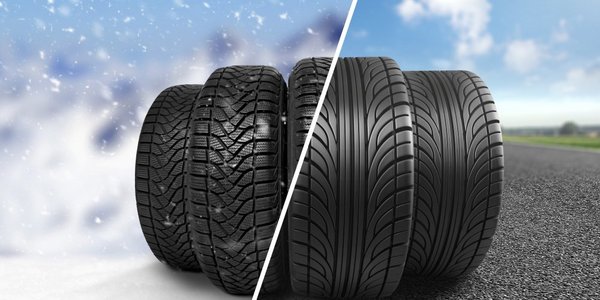
Winter and summer tyres
What is good to know
The first frost is imminent and the snow is already in the air - then it's time to prepare your car for the winter. But also the other way round, when it slowly gets warm again, it is time to put on the summer tyres.
But when and why do you have to change tyres?
A frequent question is whether there is a fixed period for the type of tyre in question - but donkey bridges such as from O(ktober) to O(stern) do not officially apply. The basic rule is that winter tyres are mandatory in "winter road conditions". This means that only tyres marked with the Alpine symbol (mountain pictogram with snowflake) are permitted in road traffic on black ice, slippery snow, slush, ice and slippery ruts. (Tyres with the M+S label (Mud and Snow) are no longer sufficient, as this designation is not subject to uniform test criteria.)
Accordingly, there is a ban on the use of summer tyres in these road conditions. However, this also means that owners who can do without their vehicle in snow and ice do not have to fit winter tyres as long as the car remains parked.
What happens if the winter tyre obligation is disregarded?
However, if you drive without winter tyres on winter roads, you are liable to a fine of 60 euros and 1 point in the driving licence register. If one even represents a handicap in road traffic, the fine is increased to 80 Euro, with endangerment to 120 Euro.
Why are there summer and winter tyres?
But not only the use of winter tyres in winter is very important - also in summer it is strongly recommended to actually drive with summer tyres and not to drive the winter tyres all year round. This can be explained by the nature of the tyres: the two types of tyre differ in their tread pattern and rubber compound.
Since the tyres have to withstand much higher temperatures in summer, the rubber compound has to be harder. For this reason, longer braking distances and greater wear are to be expected when driving with winter tyres in summer.
The most striking feature of winter tyre treads are many small sipes - this means that there are many small tread cuts which are perfect for interlocking with snow and ice and reducing the risk of slipping. The tread pattern of the summer tyres, on the other hand, is designed to displace a lot of water and is therefore better suited to ensuring stability in heavy summer rain.
So rather save money on the next fragrance tree or one or the other car wash and invest the money in your tyres - and thus your year-round safety on the road! And if you want to save even more, then you can find our blog post here about how you can easily change your tyres yourself without having to spend any money on the workshop.
![[Translate to English:] [Translate to English:]](/fileadmin/_processed_/a/1/csm_Winterreifen-Alpine-Pictogram-M-S-53375797_beb3f8c8c8.jpg)
![[Translate to English:] [Translate to English:]](/fileadmin/_processed_/b/5/csm_Fuehrerschein-Freiheit-Auto-Strasse-Unabhaengigkeit-AdobeStock-107948393_5342dc25af.jpg)